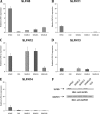Role of interferon {alpha} (IFN{alpha})-inducible Schlafen-5 in regulation of anchorage-independent growth and invasion of malignant melanoma cells
- PMID: 20956525
- PMCID: PMC3001013
- DOI: 10.1074/jbc.M110.151076
Role of interferon {alpha} (IFN{alpha})-inducible Schlafen-5 in regulation of anchorage-independent growth and invasion of malignant melanoma cells
Abstract
IFNα exerts potent inhibitory activities against malignant melanoma cells in vitro and in vivo, but the mechanisms by which it generates its antitumor effects remain unknown. We examined the effects of interferon α (IFNα) on the expression of human members of the Schlafen (SLFN) family of genes, a group of cell cycle regulators that mediate growth-inhibitory responses. Using quantitative RT-real time PCR, we found detectable basal expression of all the different human SLFN genes examined (SLFN5, SLFN11, SLFN12, SLFN13, and SLFN14), in malignant melanoma cells and primary normal human melanocytes, but SLFN5 basal expression was suppressed in all analyzed melanoma cell lines. Treatment of melanoma cells with IFNα resulted in induction of expression of SLFN5 in malignant cells, suggesting a potential involvement of this gene in the antitumor effects of IFNα. Importantly, stable knockdown of SLFN5 in malignant melanoma cells resulted in increased anchorage-independent growth, as evidenced by enhanced colony formation in soft agar assays. Moreover, SLFN5 knockdown also resulted in increased invasion in three-dimensional collagen, suggesting a dual role for SLFN5 in the regulation of invasion and anchorage-independent growth of melanoma cells. Altogether, our findings suggest an important role for the SLFN family of proteins in the generation of the anti-melanoma effects of IFNα and for the first time directly implicate a member of the human SLFN family in the regulation of cell invasion.
Figures







References
-
- Pestka S., Langer J. A., Zoon K. C., Samuel C. E. (1987) Annu. Rev. Biochem. 56, 727–777 - PubMed
-
- Katze M. G., He Y., Gale M., Jr. (2002) Nat. Rev. Immunol. 2, 675–687 - PubMed
-
- Parmar S., Platanias L. C. (2003) Curr. Opin Oncol. 15, 431–439 - PubMed
-
- Kirkwood J. M., Strawderman M. H., Ernstoff M. S., Smith T. J., Borden E. C., Blum R. H. (1996) J. Clin. Oncol. 14, 7–17 - PubMed
-
- Kirkwood J. M., Ibrahim J. G., Sondak V. K., Richards J., Flaherty L. E., Ernstoff M. S., Smith T. J., Rao U., Steele M., Blum R. H. (2000) J. Clin. Oncol. 18, 2444–2458 - PubMed
Publication types
MeSH terms
Substances
Grants and funding
LinkOut - more resources
Full Text Sources
Medical
Molecular Biology Databases

